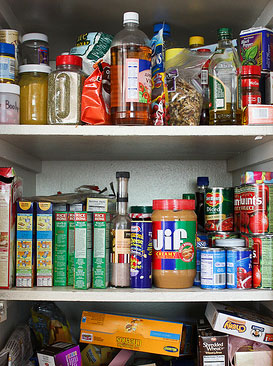How Do Food Pests Get Into My Food?
By Chris Williams on June 28, 2013.

Question
I opened a sealed box of food only to find that it was infested with bugs. How does that happen? Aren’t their controls to prevent that?
Answer
There are many stages in the production and distribution of food where pests can enter the food product. Consequently, it’s very difficult to determine where the infestation actually began—and where to place the blame. Yes, there are government inspections and various controls in place to protect our food supply, but it’s a trade-off. You can have insect-free food with an increase in pesticide use, or you can limit the use of pesticide on foods and put up with a few insects.
I don’t work in the food industry but this is a simplified explanation as to how the process works from a pest’s standpoint. Pests can infest food at any of these points from field to table:
Harvesting
Some pests are already feeding on the grain while it is in the field and are harvested right along with the product. Other pests are just waiting to lay eggs on the crop as it is being harvested.
Storage of Bulk Food
This is a very susceptible time with large volumes of raw food often in storage for a year or more. Grain in storage is often treated with pesticides to protect it from infestation. Some pests lay eggs on the stored grain and their larvae develop unseen inside the grain or rice kernel, or inside beans, only to emerge as adult beetles or moths later in the process.
Shipping of Bulk Food
Harvested foods must be shipped to markets and processing plants, sometimes on extended trips. Bulk foods can become infested during this stage when grains or crops are shipped in trucks, trains, or shipping containers that previously held insect-infested food. Infested vehicles are often fumigated.
Manufacturing and Processing
Pests can enter the food stream if a processing plant is infested. In this stage as food is subjected to cooking and cutting and crushing and processing, pests already in the product are often destroyed. This is why FDA allows a certain amount of insect fragments in our food.
Storage of Processed Food
Food that has been packaged and prepared for consumption and distribution is stored in food warehouses. Warehouses have strict sanitation and pest control guidelines to protect packaged foods, but sometimes pests sneak in.
Shipment to Retail Facilities
Again, although the products are boxed or bagged, they can still be infested in the truck, train, or container if that vehicle was not inspected and treated between shipments.
Storage at Retail Facilities
If foods are not already infested at this point, it can still happen. Incoming food items are placed on the grocery store shelf next to an already infested item; the pests move into the new boxes. Packages that have been damaged in transit are especially susceptible since pests don’t have to work too hard to get inside. Inventory stored in the back room of a store or restaurant is also susceptible to infestation.
Your Home
When all is said and done, we can’t even rule out the possibility that the food product was infested in your own home. Food pests can enter even sealed packages and can lay eggs in any exposed foods, or even on shelves. If there is an unseen, ongoing pest infestation in the back of your pantry, you could be supplying your own food pests.
Your best defense is to use products within a reasonable amount of time. Older, damaged, and damp foods are the first to become infested with pests. Rotate your foods so that the oldest items are used first and don’t store anything past its expiration date.
Photo credit: Ada Be / Foter.com / CC BY
Sign up for our biweekly email newsletter for more information about bugs and pests!